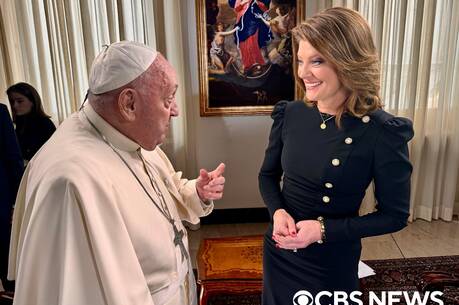Inside an empty hospital room, Mati Engel, a resident chaplain at New York City’s Mount Sinai Hospital, soothes a grieving woman over the phone. Through the speaker, you can hear that the woman is overwhelmed, struggling to comprehend the loss of her husband. “What do you believe happens after death?” she asks Engel, blowing her nose through audible tears. Carefully and attentively, Engel answers with her own personal beliefs, then provides a theological perspective, using a calm voice to ease her suffering.
“There is no right way to grieve,” Ms. Engel says, allowing the silence to linger.
“A Still Small Voice” shines a warm and instructive light on spiritual caregivers navigating a year-long residency through the pandemic.
The quiet, heartbreaking moment is one of many in “A Still Small Voice,” director Luke Lorentzen’s new vérité documentary, which shines a warm and instructive light on spiritual caregivers navigating a year-long residency through the pandemic. In this observational exploration, Mr. Lorentzen roams Mount Sinai’s halls and captures a variety of uniquely intimate scenes with patients nearing the end of life or coping with loss, his camera a witness to the unexpected, exhausting and healing work that happens in the aftermath of a diagnosis.
“It’s a field that asks the chaplain to have a deep understanding of every type of belief system you can imagine,” Mr. Lorentzen said during a recent call with America over Zoom. “And learning how to step into those shoes was something that really fascinated me deeply.”
At the center of the documentary is the relationship between Engel, who also joined the Zoom call, and the Rev. David Fleenor, an Episcoal priest and the resident supervisor. Near the end of the program, they both struggle to maintain the emotional bandwidth necessary to execute their roles effectively, leading to interpersonal tension. “A Still Small Voice” doesn’t turn away from these confrontations and vulnerabilities; it provides clear-eyed glimpses into the thorny work, religious versatility and spontaneity required of chaplaincy.
“It is an absolute miracle that there are people like Engel who show up in these situations,” says Mr. Lorentzen, who received the Best Director award in the U.S. Documentary Competition at this year’s Sundance Film Festival. “What comes with the difficulty of the work is an inherent humanness and messiness to the process of trying to do it well.”
“A Still Small Voice” provides clear-eyed glimpses into the thorny work and religious versatility required of chaplaincy.
Mr. Lorentzen first took interest in chaplaincy through his sister, Claire. A chaplain herself, she invited him to observe her residency, where she often presented cases and would discuss her daily struggles with her colleagues. As someone interested in observing personal, therapeutic work, Mr. Lorentzen quickly grew attached to the idea of chronicling chaplaincy in a more intimate way.
“I felt this very natural structure of just reflecting on the process of providing care—what worked, what didn’t work,” Mr. Lorentzen said. “I was able to learn this whole side of chaplaincy that isn’t about specific religious beliefs, but is about caring for other people through attention, empathy and open-heartedness.”
Shortly after committing to the idea, Mr. Lorentzen began reaching out to chaplaincy programs, calling around 100 different hospitals to see if any might be open to letting him follow their residents and patients. Eventually, Mount Sinai took interest, offering him the chance to shoot for a week throughout the hospital, and then allowing him more latitude once it appeared his work would be an invaluable tool for the hospital. “There was a feeling of wanting the work that this department does to be more fully understood,” he said, “and to really deeply show the work in a way it had not been documented and shared before.”
Still, Mr. Lorentzen had to fight other barriers. Though he had access to the hospital, he wanted to gain the trust of the residents—specifically Engel, with whom he felt a deep connection—and the patients themselves. “It took many months of really talking and getting to know one another before we were able to start filming in very small ways,” Lorentzen said. Engel was initially skeptical, wanting to preserve the essence of her work and asked specific questions about his filmmaking process. “How do you enter a room and not interrupt or contaminate the experience with the patient?” she asked him. “How can this be an extension of healing?”
Mr. Lorentzen shot the documentary throughout 2021, when physician burnout and the health care industry’s “Great Resignation” became a major topic of discussion.
Mr. Lorentzen eased some of her worries by operating as a one-man crew (only he would enter rooms with the camera), making it simpler to build a rapport and develop a structure and protocol around being filmed so that patients could retroactively request anonymity or discretion. “The film really started to take off when Mati and I started to think about the camera not as something to be ignored—as if the goal was for it to be invisible in the patient’s room—but as a tool that could be used to enhance the feeling of being seen.”
“Suddenly there’s not only two eyes, but a massive God’s eye in the room, which is the camera lens,” Ms. Engel said in our interview. “To be witnessed on that level and have your story seen on such a big platform and feel like you exist and you matter, that also has a healing component to it.”
Mr. Lorentzen felt that burden during the documentary’s most moving scene, in which a young married couple loses one of its twin girls during birth and requests she still be baptized. As the only resident on call, Engel quickly finds a Bible and has a colleague help her navigate through various passages that would be appropriate to read. It’s a stirring moment watching Engel adjust to the room, feel the weight of the parents’ loss and begin to pray with them.
It’s a stirring moment watching Engel adjust to the room, feel the weight of the parents’ loss and begin to pray with them.
“That was one of the really difficult, heavy parts of making this film: asking people to be there in these moments and then feeling enormously responsible to take care of them, to use the footage in a way that did justice to the invitation that I was given,” Mr. Lorentzen said.
At one point, the father asks if he can read a few chapters from Jeremiah before Engel brings out holy water, doing her best to stay present and attentive to everyone’s needs and emotional temperature. As someone from an orthodox Jewish background, trying to read the right biblical passage was “absolutely nerve-wracking,” Ms. Engel recalled, but she remained assured in her approach. “That was really a great example of what it requires to be a chaplain that’s fully present and active and engaged,” she said.
Mr. Lorentzen shot the documentary throughout 2021, when physician burnout and the health care industry’s “Great Resignation” became a major topic of discussion. Though “A Still Small Voice” does not give a lot of attention to the pandemic’s toll, it still illuminates the challenge for so many spiritual caregivers: to produce empathy and full presence of mind on a 9-to-5 schedule when the world around them seems to be burning. “Is that humanly possible, especially when you have cases that really hit close to home and might bring up some triggers in you?” Ms. Engel wondered. “You might need a couple days to not come into the office and just rebound.”
The work takes a toll on Ms. Engel. Tension brews with Fleenor and she withdraws from the program before its completion, frustrated by the requirements of compartmentalizing work with patients who need more care after hours. But Engel finds the drama of her situation to be instructive. She hopes her experience will inspire more empathy for chaplains and other health care providers who take on the responsibilities of guiding people through their most challenging times.
“The work is also internal, and you need space and you need rest and you need things going on outside your life,” Ms. Engel says. “I don’t know that we have a good understanding of how much spaciousness you need.”
In some ways, the country has yet to properly grapple with the pandemic and mourn for the one million Americans who lost their lives to the virus. Mr. Lorentzen’s documentary offers a cathartic opportunity to grieve—and watch a small group of individuals do their best to shoulder the burdens of that heavy work. “In spending time with Engel and every chaplain in the department, there was a mix of absolute magic and brokenness that was in play,” Mr. Lorentzen said.
“As a filmmaker...I experienced that balance of feeling a lot of really burned-out, dreadful feelings, and a lot of hope and inspiration,” he said. “It’s something I’m still figuring out what to do with.”








